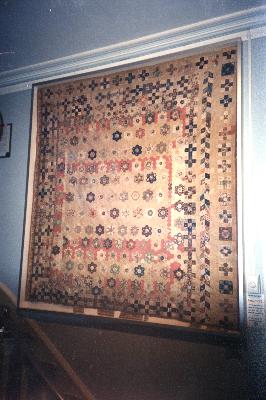Quilt No.513NHM - Narryna Heritage Museum

2000 x 1800mm
The quilt was made by Mary Harper of County Dublin, Ireland c.1830 for her trousseau. In 1851 Mary and David and their 2 children came to Van Diemen's Land and settled in Fingal. The quilt remained in the family but was not specifically handed down from one generation to the next. In 1955 it was donated to the Narryna Heritage Museum by the Misses Pat and Etta Weetman great grand-daughters of Mary Harper. The quilt is displayed in a wall cabinet at the Museum
Mary Gall (?-1878) came from Dublin and probably met her future Scottish husband, David Harper, when she was staying in Scotland in 1833. They were married in 1837 at Dunboune near Dublin and had 2 children, Alexander born in 1837 and Rosa in 1839. In 1851 the family came to Van Diemen's Land where David was steward or manager to William Talbot at Fingal. He later took over the flour mill at Millbrook, Mt. Nicholas. Rosa, the donor's maternal grand-mother married John Stanfield of 'Speyside' Fingal in 1866. Rosa and John's daughter, Rosetta Mary was born in 1867 and Mary Margaret in 1869. John Stanfield's diary of 1870 refers to domestic details such as "Rosa papering the dining room today" and "Mary walked for the first time".
Rosa's elder daughter did not marry but Mary married Percy Weetman in 1905 and their 2 daughters, Mary Patricia b.1906 and Rosetta (Etta) b.1910 were the donors of the quilt to the Narryna Heritage Centre c.1955.*
[Ref: Compilation by Anne Piesse, Hobart, 1985 from notes, letters and interviews with Etta Weetman]
Related Quilts:
1601 x 1525mm
2000 x 1450mm
2500 x 2130mm
2540 x 2370mm






